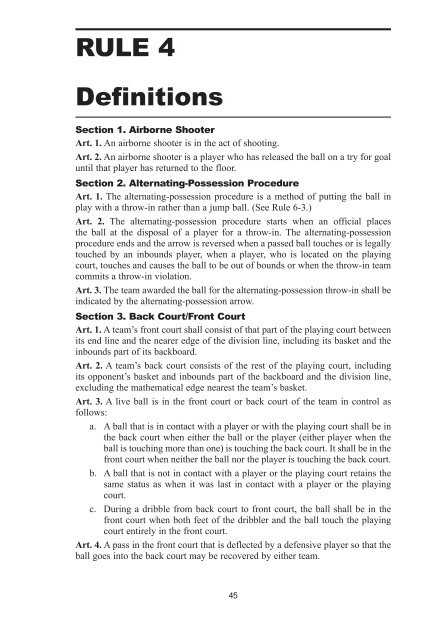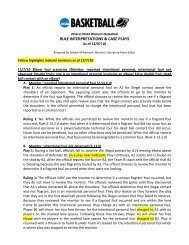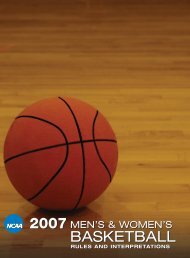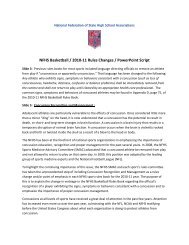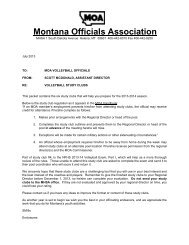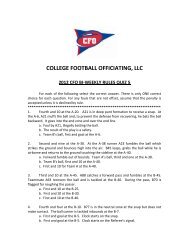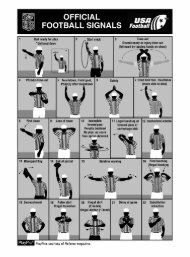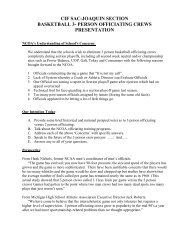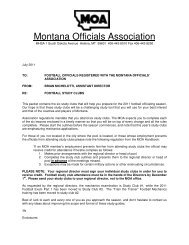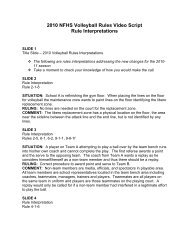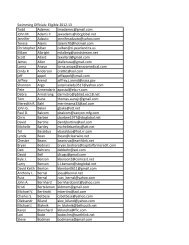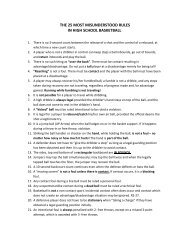2011-12 AND 2012-13 MEN'S AND WOMEN'S RULES - NAIA
2011-12 AND 2012-13 MEN'S AND WOMEN'S RULES - NAIA
2011-12 AND 2012-13 MEN'S AND WOMEN'S RULES - NAIA
You also want an ePaper? Increase the reach of your titles
YUMPU automatically turns print PDFs into web optimized ePapers that Google loves.
RULE 4<br />
Definitions<br />
Section 1. Airborne Shooter<br />
Art. 1. An airborne shooter is in the act of shooting.<br />
Art. 2. An airborne shooter is a player who has released the ball on a try for goal<br />
until that player has returned to the floor.<br />
Section 2. Alternating-Possession Procedure<br />
Art. 1. The alternating-possession procedure is a method of putting the ball in<br />
play with a throw-in rather than a jump ball. (See Rule 6-3.)<br />
Art. 2. The alternating-possession procedure starts when an official places<br />
the ball at the disposal of a player for a throw-in. The alternating-possession<br />
procedure ends and the arrow is reversed when a passed ball touches or is legally<br />
touched by an inbounds player, when a player, who is located on the playing<br />
court, touches and causes the ball to be out of bounds or when the throw-in team<br />
commits a throw-in violation.<br />
Art. 3. The team awarded the ball for the alternating-possession throw-in shall be<br />
indicated by the alternating-possession arrow.<br />
Section 3. Back Court/Front Court<br />
Art. 1. A team’s front court shall consist of that part of the playing court between<br />
its end line and the nearer edge of the division line, including its basket and the<br />
inbounds part of its backboard.<br />
Art. 2. A team’s back court consists of the rest of the playing court, including<br />
its opponent’s basket and inbounds part of the backboard and the division line,<br />
excluding the mathematical edge nearest the team’s basket.<br />
Art. 3. A live ball is in the front court or back court of the team in control as<br />
follows:<br />
a. A ball that is in contact with a player or with the playing court shall be in<br />
the back court when either the ball or the player (either player when the<br />
ball is touching more than one) is touching the back court. It shall be in the<br />
front court when neither the ball nor the player is touching the back court.<br />
b. A ball that is not in contact with a player or the playing court retains the<br />
same status as when it was last in contact with a player or the playing<br />
court.<br />
c. During a dribble from back court to front court, the ball shall be in the<br />
front court when both feet of the dribbler and the ball touch the playing<br />
court entirely in the front court.<br />
Art. 4. A pass in the front court that is deflected by a defensive player so that the<br />
ball goes into the back court may be recovered by either team.<br />
45


